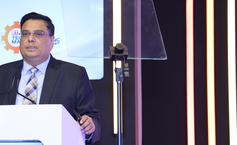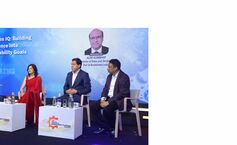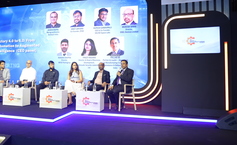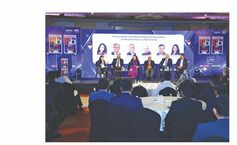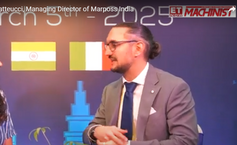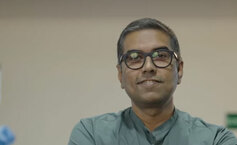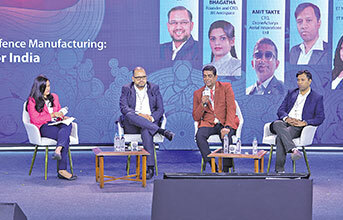
As global dynamics continue to evolve—for India and the world at large—the need for a robust strategic defence framework has never been more vital. A panel of distinguished figures from the aerospace and defence sectors, including—Amit Mahajan, Director at Paras Defence & Space Technologies Ltd; Amit Takte, CTO at DroneAcharya Aerial Innovations Ltd; and Mahavir Kanwade, COO at Aethrone Aerospace Pvt. Ltd— gathered to explore this imperative. The discussion, titled Strategic Defence Manufacturing: A Vision for India, was moderated by Nisha Shukla, Senior Assistant Editor at ET Now Machinist and ET Now Polymers.
Shukla opened the session by asking how far India has progressed in aerospace and defence manufacturing — particularly in achieving self-reliance and technological advancement. "We speak so often of ‘Make in India', but where do we actually stand?" she questioned.
Responding to the question, Mahajan expressed both optimism and realism. "I must say I'm very pleasantly surprised to see defence manufacturing being given space in this forum. It's a sign of where technology is headed— defence will be at the forefront of innovation," he began.
He acknowledged that while there is still significant ground to cover, the pace of progress has exceeded expectations. "In terms of self-reliance, we still have a lot to achieve. That said, we're moving much faster than anticipated—in innovation, in developing advanced systems, and in asserting ourselves on the global stage," Mahajan noted.
He pointed out that India is already becoming self-reliant in critical technologies such as radars and missile systems, which were once heavily dependent on imports. However, he stressed that continued progress would hinge on deepening innovation and investing heavily in skill development, particularly in defence and aerospace engineering. "Much has been said about skill development, but when it comes to defence, we need to do much more. That's where the next leap will come from," he added.
Mahavir Kanwade, Chief Operating Officer of Aethrone Aerospace Pvt. Ltd., expressed his appreciation for being part of the discussion and highlighted India's growth in traditional warfare systems like artillery and the increasing role of private players.
However, he flagged a significant gap in specialised technologies, particularly in aerospace materials and engine components. While there had been progress, he stressed the need for greater innovation and a skilled workforce, echoing broader concerns about talent shortages in defence and aerospace.
Kanwade described drone technology as a current buzzword, noting the rise of over a thousand drone manufacturers in India and their growing role beyond defence—in sectors like e-commerce and logistics. Citing the Ukraine conflict, he pointed to a shift from traditional warfare to mission-critical systems such as drones and platform-agnostic technologies.
His company, he said, focused on integrated systems spanning land, sea, and air, rather than isolated defence products—a systems-based approach vital for modern warfare. While India had made strides in traditional systems and exports, Kanwade emphasised the need to build critical aerospace capabilities to meet future challenges.
Amit Takte, CTO at DroneAcharya Aerial Innovations Ltd, addressed the growing role of drones in defence with clarity and conviction. He said drones had become vital to modern warfare worldwide, with India embracing the technology at an impressive pace. While challenges remained, defencegrade drone manufacturing was now a key priority.
Takte outlined their current use— from reconnaissance and kamikaze drones to logistics support in remote areas—and highlighted the rising importance of anti-drone systems. He stressed that drones were now essential not only in defence but in civilian applications too.
Looking ahead, he identified AI as a game-changer, especially in enabling drone swarming—multiple drones flying in coordinated, automated missions. He also spoke of advancements in drones that can operate in areas with limited communication, such as border zones.
Finally, he mentioned the potential of long-endurance, solar-powered drones capable of flying for over eight hours. Takte was confident that such innovations would significantly boost the capabilities of India's armed forces.
When asked by Shukla on how Indian companies and global players could collaborate to ensure safe and secure technology transfer while safeguarding national interests, Amit Mahajan offered a thoughtful response.
He emphasised that "Indian firms must bring both value and readiness to the table—value in terms of quality, processes, and cost-effectiveness, and readiness through skilled talent, infrastructure, and proactive investment." These, he said, were key to meaningful global partnerships and faster development.
However, Mahajan challenged the prevailing mindset, arguing that India must stop depending on foreign players for innovation. He believed the country should see itself as capable of creating world-first technologies, rather than just catching up.
Citing examples from Paras Defence, he said the company was developing products never attempted before in the Asia-Pacific, including by countries like Japan and South Korea. This, he felt, proved that Indian companies could lead in innovation.
Mahajan concluded by saying that innovation need not remain the West's domain and that India should not just look for global partners—but strive to become one.
He also highlighted a major milestone, sharing that his company is the only one in the Asia-Pacific to have developed a submarine periscope— surpassing even nations like Japan. If one wanted a periscope made in India, he stated, Paras was the sole option.
Mahajan also touched on anti-drone systems, inspired by earlier remarks from Amit Takte. Paras, he said, had created an integrated drone detection and jamming system that he claimed was unmatched globally. Its standout feature was a single antenna covering a wide frequency range of 400 MHz to 6 GHz.
Mahajan noted that the system had caught the attention of Western companies—not as a buyer of their tech, but as a partner recognising India as the innovator. "This is the mindset every Indian company should adopt," he urged. "Let's lead in technology and have the world follow," he added.
Building on the discussion, Amit Takte offered a drone industry perspective in light of Mahajan's call for technological self-reliance. He agreed that indigenous development must be central but acknowledged India's current dependence on global tie-ups to keep pace with rapid international progress, especially in defence.
Takte noted that technology transfers were happening, allowing Indian firms to adapt drone tech for national needs. However, he warned that over-reliance on such partnerships could hinder India's strategic autonomy.
He urged a shift towards in-house innovation, led by Indian bodies like DRDO and academic institutions. "Foreign collaboration has its place," he said, "but it should support—not substitute—our own innovation."
While India had made solid strides, Takte stressed that major R&D investment was still needed to close critical gaps and establish India as a serious player in drone warfare. When asked about the state of R&D in India's aerospace and defence sectors, Amit Mahajan was first to respond. He noted that research remained largely centralised in government institutions, with DRDO at the helm. While he praised DRDO's efforts, he acknowledged progress was slower than ideal.
Mahajan pointed out that India had a wealth of defence and aerospace knowledge but needed to move faster. Encouragingly, he said, DRDO had begun outsourcing innovation to private industry, a shift he called both necessary and overdue.
He expressed hope that this would gather momentum, with private players speeding up development, creating jobs, and driving innovation. Though challenges remained, he believed India was finally moving in the right direction towards a more agile and decentralised R&D ecosystem.
Echoing Mahajan's views, Mahavir Kanwade shared his perspective, stressing that while India often seeks solutions abroad, it must begin by addressing its own challenges. At Aethrone, he said, this approach was already in play—tackling problems raised by defence bodies like the Indian Air Force and building solutions in-house. He cited the IAF's 2022 doctrine on adaptability and reach as a guiding reference for their work.
Kanwade noted that India's IT strength was an underused asset, especially given the role of communication, intelligence, and information in modern warfare. He saw great scope for closer ties between the IT and defence sectors, which currently operate in silos despite strong capabilities.
On manufacturing, he acknowledged India's limited experience in critical areas like engine components. While indigenous development was vital, he advocated selective collaboration with friendly nations to fill knowledge gaps—so long as it supported rather than replaced local innovation.
As an example, he mentioned India's success in developing artillery systems suited to its own conditions— unlike imported systems not designed for local terrains. This, he said, reinforced the need for homegrown solutions tailored to Indian realities.
Kanwade identified two focus areas: critical components and electronics. He pointed to the rapid advances in automotive semiconductors and urged similar momentum in defence. AI and machine learning, he added, could transform decision-making in the military.
On policy, he appreciated the push for localisation but called for stronger R&D incentives. He suggested DRDO partner more actively with startups by providing access to infrastructure and expertise.
On supply chains, he cited delays in the Tejas Mark 1 programme— particularly the unavailability of the F404 engine—as a clear case for building domestic capabilities. While drones drew attention, he stressed the need to also prioritise fighter aircraft and reduce import dependence, especially in defence aviation.
Kanwade concluded by emphasising the need to develop both hardware and software. Defence, he noted, is a long-gestation sector, and projects like the MCAR jet—targeted for 2035—must be taken up now to secure India's place on the global stage.
Amit Mahajan then weighed in, acknowledging that India was, in many respects, far from achieving parity with countries like Russia, China, or the United States when it came to technological capabilities. However, he pointed out that India's strength lay in its diplomatic leverage. He remarked that India's peace and security were largely safeguarded by the strong bilateral relations it maintained with a wide range of nations—a position, he claimed, even the United States might envy. He argued that these strategic relationships had bought India the time and space it needed to grow into a defence superpower. While the country was not yet there technologically, he believed India was on the right path.
Amit Takte then added to the discussion by speaking specifically about drone technology. He referred to the target set by the Honourable Prime Minister—to make India a global hub for drone technology by 2030. He asserted that to meet this ambitious goal, manufacturing would play a critical role. It was not sufficient to focus only on innovative applications or software development, he said; self-reliance would also require India to design and manufacture the hardware components of drone systems indigenously.
Wrapping up the conversation, Mahavir reiterated the importance of synchronising efforts on both hardware and software fronts. He emphasised the need to control the entire value chain—from the sourcing of raw materials and minerals to final product assembly. Only by doing so, he argued, could India establish a robust, reliable, and globally competitive supply chain for the defence sector.
When Shukla asked about his vision for India's defence manufacturing by 2030, Amit Mahajan said innovation would be the key driver. He stressed the need for stronger investment in R&D and a shift in mindset, noting that Indian companies often worked in silos rather than collaborating on integrated solutions—though this, he added, was slowly changing.
On skills, Mahajan highlighted semiconductors and material sciences as critical areas. Regardless of other progress, he said, these would remain the biggest hurdles. India must master both to unlock its full defence potential.
Amit Takte also underlined the importance of involving educational institutions, engineering colleges, and R&D organisations in the process. He believed their participation would be crucial in developing self-reliant designs and fostering a culture of innovation-led product development within the country. Takte expressed confidence that with the available talent pool and strong government backing, India would be well on its way to achieving the ambitious targets it had set for itself in the defence sector.
Offering a more application specific view, Mahavir Kanwade shared a vision grounded in innovation and practicality. Looking to 2030, he noted that while drones had become central to modern warfare, his team was already thinking beyond deployment—focusing on what happens when things go wrong. What if a drone failed mid-mission or during combat?
He revealed that his organisation was developing search and rescue technologies, particularly for naval use. After successful trials with the Indian Navy, they had systems ready to rescue personnel who'd fallen overboard. His team was also working on rescue solutions for drones, an area he said had received little attention despite drones becoming vital defence assets.
Mahavir described parachute based ejection systems and other drone recovery tools aimed at avoiding collateral damage during mission failures. He said his goal was to lead in parachute and para-rescue technologies, especially for drones. Beyond defence, they were tailoring these systems for other platforms and sectors. For him, the future lay in building a full ecosystem of rescue and recovery systems to safeguard both human lives and critical defence tech.







